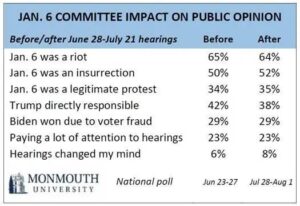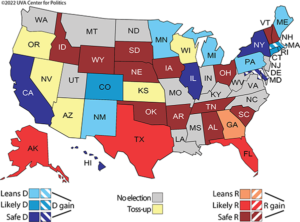I’m always encouraged when I see a really good Democratic political ad. But does it really matter, and if so, how much? Maybe it’s impossible to say for sure. What we can know is, what the best data says about it.
Writing in 2020, Mike Cummings takes the skeptical view in “Political ads have little persuasive power” at Yale News: ”
Every four years, U.S. presidential campaigns collectively spend billions of dollars flooding TV screens across the country with political ads. But a new study co-authored by Yale political scientist Alexander Coppock shows that, regardless of content, context, or audience, those pricey commercials do little to persuade voters.
The study, published Sept. 2 in the journal Science Advances, measured the persuasive effects of 49 high-profile advertisements from the 2016 presidential campaign on a nationally representative sample of 34,000 people through a series of 59 randomized experiments. Expanding on prior research suggesting that political ads have little impact on voters’ preferences, the study shows that those weak effects are consistent irrespective of a number of factors, including an ad’s tone, timing, and its audience’s partisanship.
“There’s an idea that a really good ad, or one delivered in just the right context to a targeted audience, can influence voters, but we found that political ads have consistently small persuasive effects across a range of characteristics,” said Coppock, an assistant professor of political science in the Faculty of Arts and Sciences. “Positive ads work no better than attack ads. Republicans, Democrats, and independents respond to ads similarly. Ads aired in battleground states aren’t substantially more effective than those broadcast in non-swing states.”
OK, 2016 was weird, and Cummings’s article was focused on TV ads. Regarding the study’s methods, Cummings writes:
Coppock and his co-authors — University of California-San Diego political scientist Seth J. Hill and UCLA political scientist Lynn Vavreck — conducted the study throughout the 2016 presidential primaries and general election.
Over 29 weeks, a representative sample of Americans was divided at random into groups and assigned to watch campaign advertisements or a placebo advertisement — a car-insurance commercial — before answering a short survey.
The researchers selected ads using real-time, ad-buy data and news coverage of each week’s most important ads. They tested ads attacking or promoting Republican candidate Donald Trump and Democratic candidate Hillary Clinton as well as commercials concerning primary candidates, such as Republican Ted Cruz and Democrat Bernie Sanders. They analyzed the ads’ effects on survey respondents across several variables, including the candidate, party, or political action committee that sponsored them; whether they were positive or negative in tone; the partisanship of those viewing the ads; the time to Election Day when they aired; whether they were viewed in a battleground state or not; and whether they aired during the primary or general election.
Cummings summarizes their findings:
They found that, on average and across all variables, the ads moved a candidate’s favorability rating among respondents only .05 of a point on the survey’s five-point scale, which is small but statistically significant given the study’s large size, note the researchers. The ads’ effect on whom individuals intended to vote for was smaller still — a statistically insignificant 0.007 of a percentage point.
Campaigns should carefully consider efforts to tailor advertisements to specific audiences given that the evidence shows that ads’ persuasive effects vary little from person to person or from commercial to commercial, the researchers concluded.
Of course a candidate’s favorability rating is not the same thing as a vote for or against a candidate. As Cummings notes further,
The findings do not demonstrate that political advertising is always ineffective, Coppock said, noting that the study didn’t analyze the influence of an entire advertising campaign.
“TV ads help candidates increase their name recognition among the public, which is extremely important,” said Coppock, a resident fellow at Yale’s Institution for Social Policy Studies and the Center for the Study of American Politics. “Moreover, the effects we demonstrated were small but detectable and could make the difference between winning and losing a close election.”
Another study of TV ads in the 2020 election in 75 market areas and 1607 counties by Northwestern University scholars Brett Gordon, Mitchell J. Lovett, Bowen Lou and James Reeder found, as reported by Roberta Kwok :
….Gordon and his colleagues report that TV ads do influence voter turnout and choices—and that the tone of the ad makes a difference. Based on data from the 2000 and 2004 presidential elections, the team found that positive ads encouraged more people to show up on Election Day, while negative ads slightly suppressed turnout. And while both types of commercials affected whom people supported, the negative ones were more effective at swaying voters’ decisions.
In hypothetical scenarios, the researchers found that ad tone was sometimes enough to tip a close election. For example, the team predicted that if only positive ads had been shown, Al Gore would have won in 2000.
The results suggest that in tight races, “political TV ads matter,” Gordon says. “They drive outcomes.”
Kwok notes further that “Some studies that evaluated the overall influence of ads, without distinguishing between positive or negative ones, found that the commercials didn’t affect turnout. Among researchers who analyzed specific ad types, some reported that both positive and negative commercials had little effect; others found that negative ads boosted turnout; and still others that negative ads decreased turnout….The researchers found that, in the 2000 election, allowing only positive ads would have increased overall voter turnout from 50.4 percent to 52.4 percent. Meanwhile, airing only negative ads would have decreased turnout to 48.8 percent. The gap between the all-positive and all-negative scenarios was about 10 million voters.”
Regarding the thorny problem of campaigns continuing to spend billions of dollars on TV ads in elections every year, highly-experienced campaign managers know about such studies, but they still think TV ads are very important. The cynical argument goes, “Well, the system is corrupted by massive amounts of money they have to spend somewhere.” No doubt, however, many campaign managers can point to evidence that specific ads helped their candidates.
So who do you trust more – academics defending their studies, or campaign managers and consultants defending their investments? No shortage of self-interest on either side of that argument. Kind of a draw, isn’t it?





